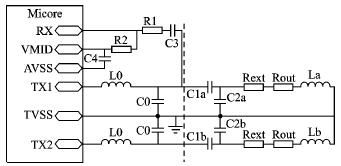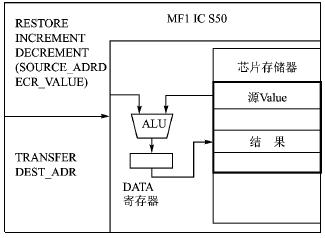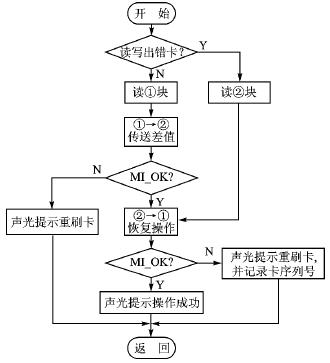An integrated circuit card (IC card), also known as an "integrated circuit card", is an integrated circuit chip embedded in a plastic substrate and packaged in the form of a card having a shape similar to that of a magnetic card covering a magnetic strip. As a safe, convenient and fast payment tool and a lightweight and detailed personal information database, IC card has been favored by users in modern society. In particular, the emergence of non-contact radio frequency IC cards greatly facilitates the use of users, and overcomes the disadvantages of the conventional contact IC card contacts being easy to wear and inconvenient to use. But it also brings some problems. Because it is a non-contact IC card, sometimes the user swipe the card too fast, which will cause the IC card reader to not complete the operation of the IC. The card has left the antenna area, and unpredictable consequences occur. Seriously, the data in the IC card will be lost, causing losses to the user. These problems are mainly caused by both hardware and software factors. In terms of hardware, it is mainly related to individual differences in antennas and cards. We have experimented that different card readers have a large difference in card reading distance even on the same card reader; similarly, the card reading distances of the same card on different card readers are also very different. The shortening of the read/write distance causes the card to be read and written without being completed for a certain period of time, and an abnormal situation occurs. On the software side, some compensation measures can be taken while minimizing the operation time of the card to make up for the innate hardware shortage, thereby improving the reliability operation of the IC card and avoiding some unnecessary
The trouble is necessary.
Philips is the world's first company to develop contactless IC cards, with Mifare standard, Mifare Light, Mifare PLUS and Mifare PRO. Taking the Mifare standard series MF1 IC S50 as an example, according to the Philips standard, the data exchange time between the card and the reader antenna can be less than 0.1 s. However, in practice, for a variety of reasons, the transaction time is longer than this, and if it is not handled well, there will be unpredictable consequences.
1 Non-contact IC card antenna composition
The non-contact IC card antenna is a decisive factor affecting the performance of the card reading. The quality of the antenna design directly affects the stability of the card reading system. As shown in FIG. 1, the entire antenna portion circuit is composed of an EMC filter circuit, a receiving circuit, and an antenna coil circuit. The function of the EMC filter circuit is to attenuate the influence of higher harmonics generated by the antenna transmitting circuit on the outside world. The receiving circuit is composed of R1, R2, C3, and C4. The role of R2 and C4 is to make the DC level on the receiving pin RX coincide with the internal reference voltage output VMID; R1 is used to adjust the amplitude of the AC signal on the receiving pin RX. The circuit shown to the right of the dashed line is the antenna to be designed, including the antenna coil and the associated resonant components. Among them, Rext is used to adjust the quality factor of the antenna, and the center frequency f of the antenna and the external output impedance Za are mainly adjusted by changing the values ​​of the resonant capacitors C1a, C1b, C2a, C2b. Therefore, the determination of the external resistor Rext and the resonant capacitor component parameters is an indispensable part of the antenna coil circuit design. According to Philips' non-contact IC card antenna design data, antenna tuning is divided into two steps: 1 Adjust the antenna's resonant frequency f and output impedance Za to the desired 13.56 MHz and 500 Ω; 2 Adjust the antenna to find the largest Reading distance. The specific method is to connect the antenna into the circuit, and then, when the system is working, continuously adjust the value of C2 and test the read/write distance of the card until the value of C2 is found when the maximum card reading distance is found. The purpose of finding the maximum card reading distance is to make the card enter the antenna radiation range for a long enough time to complete the card operation satisfactorily.

Figure 1 Antenna module circuit
2 Non-contact IC wallet function
Value cards are generally used for small purchases, and e-wallets are a typical application. The operation of the electronic wallet includes READ, INCREMENT, DECREMENT, TRANSFER, and RESTORE. The e-wallet is generally stored in a value segment manner, and the manufacturer also provides a value segment operation function to facilitate user development. Value segments are also called "Value Blocks" and Value is 4 bytes long (including sign bits). To improve error detection and error correction, each Value is stored 3 times in a Value Block as follows:

The consistency of the three Values ​​is checked inside the chip before any calculation is performed. The remaining 4 bytes (A and ) are 8-bit arbitrary address bytes, and the same address is stored 4 times (A and ).
The contents of the Value Block are first written to the requested address by the WRITE command, and can be modified later using the DECREAMENT/INCREMENT/RESTORE command. The calculation process of the data is shown in Figure 2. The result of the calculation is temporarily stored in the DATA register (ie, the data register), and then written to the register using the TRANSFER command.

Figure 2 Value calculation diagram
3 software implementation
The MF1 IC S50 has 8 Kb EEPROM divided into 16 zones, each zone is divided into 4 blocks (Block0~3), and one packet has 16 bytes. For the convenience of users, Philips has given the value segment operation function M500PiccValue(), which can be used to easily perform operations such as INCREMENT, DECREMENT, TRANSFER, and RESTORE. However, this function has certain defects. When the return value is "non-MI_OK", there are two cases: 1 value operation is not completed, the value is unchanged; 2 value operation is completed, and the value is correct. This will make it impossible to determine whether the value operation succeeded or not based on the function return value (only the return value is MI_OK to determine that it is correct). In other words, although it can be determined that the operation is correct when MI_OK, but the operation may be completed when it is "non-MI_OK", the operation may not be completed. Therefore, if this is the return value operation, then wait until MI_OK, there will be more The phenomenon of operation. For example, if you need to brush the card for 1 yuan, it may deduct 2 yuan, 3 yuan, or even more. This is certainly not what you expect to see.
In view of the above situation, in order to ensure that the card can be operated correctly and data is not lost, two data blocks are generally divided into one electronic wallet in one area, and stored in a value segment format, which is respectively defined as a main value block (1 block). And the backup value block (2 blocks), the primary value block and the backup block are backed up to each other.

Figure 3 software operation process
First, the value obtained by subtracting the value of the main value block from the consumption amount is stored in the backup value block (1 block → 2 blocks, using the "subtract" and "transfer" operations), and the main value block has not changed yet; if this operation is MI_OK, continue the following operation to return the value of the backup value block back to the main value block (2 blocks → 1 block), using the recovery operation; if the operation is MI_OK, then the values ​​of 1 block and 2 blocks are equal. Each step of the operation judges the result, and if it fails, it is redone. The specific software operation process is shown in Figure 3.
4 Conclusion
As a kind of value card, e-wallet is very important for the stability of its operation. In terms of hardware, try to adjust the card reader antenna's card reading range to the maximum distance of the card reader to ensure that the card and antenna have sufficient time coupling to create a good hardware condition for the card. However, due to the individual differences in card readers and personal swiping habits, it can also cause some anomalies. At this time, software is needed to make up for the deficiencies in the hardware. The two-value block operation sacrifices some time of card swiping, but solves some problems in the single-value block operation. Even if there is a problem with one value block, the data can be transmitted from another value block, thereby improving the stability of the system. . In addition, in order to ensure that the operation of the card can be completed before the card leaves the antenna, some sound and light prompts can be added as an aid (for example, the sound and light prompt is performed after the operation is successfully completed). These details are also necessary. The method has been rigorously tested indoors and put into operation, and the work is stable.
Our Professional Hair Clippers have excellent ceramic knife head, hard texture, long service life, anti-corrosion, good sharpness, lighter sound, durable, low noise. Beautiful appearance, light weight, flexible and labor-saving operation, low vibration and low noise. This professional hair clippers are suitable for all age using and safety operation. It is comfortable handle suitable for domestic or professional salon use and popular use throughout the world.
Hair Clippers
Hair Clippers,7 In 1 Hair Trimmer,Electric Hair Clipper Knife,Pet Hair Clipper
Gold Beauty Limited. , https://www.goldbeautyltd.com
